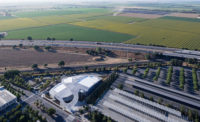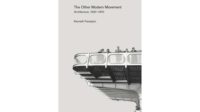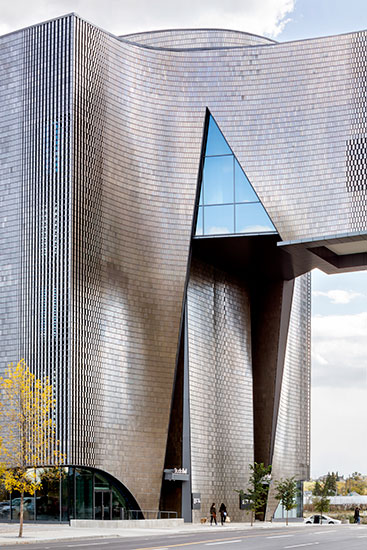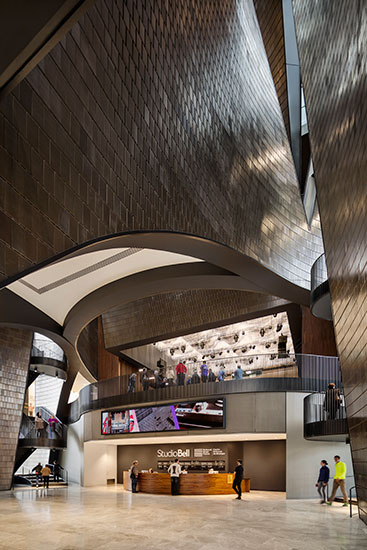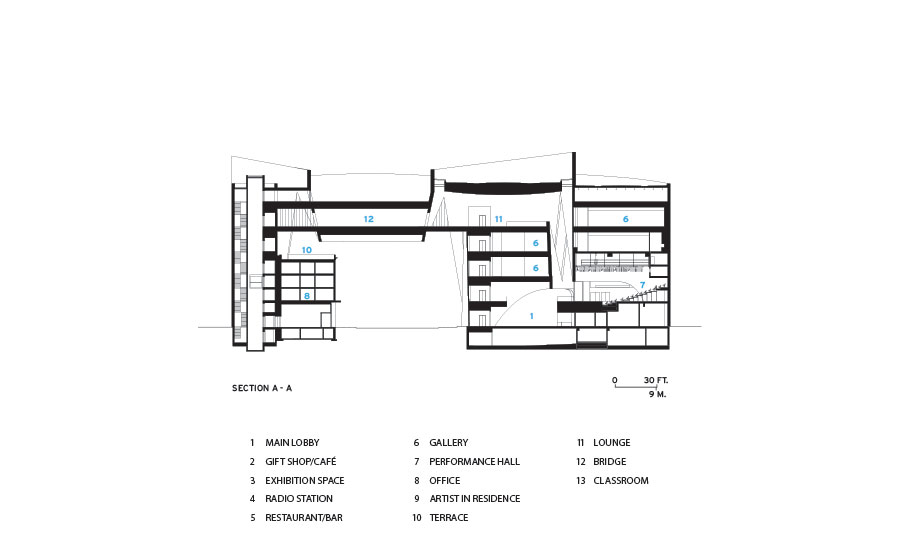National Music Centre of Canada by Allied Works Architecture
Calgary

Photo courtesy Allied Works Architecture, © Jeremy Bittermann

The interlocking volumes allow views between and across interior spaces.
Photo courtesy Allied Works Architecture, © Jeremy Bittermann

The fifth-floor lounge, known as “the Cloud,” is an open space that invites reflection and offers stunning views of the interior.
Photo courtesy Allied Works Architecture, © Jeremy Bittermann

Music from the 300-seat performance hall on the second floor spills out to other spaces, including the main lobby below it.
Photo courtesy Allied Works Architecture, © Jeremy Bittermann

The theater’s ceiling features an array of hanging aluminum tubes.
Photo courtesy Allied Works Architecture, © Jeremy Bittermann

Visitors in exhibition spaces at Studio Bell.
Photo courtesy Allied Works Architecture, © Jeremy Bittermann

The building, inside and out, is covered in over 200,000 terra-cotta tiles. A connecting bridge rises 65 feet above the street.
Photo courtesy Allied Works Architecture, © Jeremy Bittermann

The curving volumes and helical staircases combine for a dynamic spatial experience.
Photo courtesy Allied Works Architecture, © Jeremy Bittermann

The complex, known as Studio Bell, connects two properties on opposite sides of a street at the threshold of Calgary’s newly emerging East Village neighborhood. It incorporates a squat century-old brick building that once housed the King Edward Hotel, the site of a legendary blues club.
Photo courtesy Allied Works Architecture, © Jeremy Bittermann

Studio Bell lobby.
Photo courtesy Allied Works Architecture, © Jeremy Bittermann

The curving volumes and helical staircases combine for a dynamic spatial experience.
Photo courtesy Allied Works Architecture, © Jeremy Bittermann

Galleries feature end-grain oak floors and ceilings of black-painted aluminum grilles.
Photo courtesy Allied Works Architecture, © Jeremy Bittermann

Image courtesy Allied Works Architecture

Image courtesy Allied Works Architecture

Image courtesy Allied Works Architecture

Image courtesy Allied Works Architecture

Image courtesy Allied Works Architecture

















Architects & Firms
Allied Works Architecture (AWA) doesn’t enter open competitions often. The Booker T. Washington High School for the Performing and Visual Arts in Dallas was a rare exception for the firm. Just as that school project was finishing up, AWA principal Brad Cloepfil found the brief—and site—for the National Music Centre of Canada (NMC) in Calgary, Alberta, too intriguing to pass up. Cloepfil had visited Calgary as a teenager, making a stop in the city’s infamous King Edward Hotel, which housed a seedy but much-loved blues bar. It is around that century-old landmark that Cloepfil’s spectacular new building for NMC, called Studio Bell, takes shape.
Additional Content:
Jump to credits & specifications
By the time the “King Eddy” closed in 2004, not much was left of its East Village neighborhood. The area was decimated, with blighted buildings and vacant lots. Cloepfil was faced with a challenge: “How do you hold the site when there’s nothing there?”
Instead of looking to the urban context, AWA drew inspiration from the unique Canadian Rockies landscape just outside Calgary, particularly its hoodoos, or rock formations. Cloepfil first learned about them from Clyfford Still’s paintings when he was designing the Denver museum dedicated to the artist’s work. Still had painted the hoodoos near his Bow Island home in southern Alberta in the late 1930s.
Like those rocky outcrops, the 181,000-square-foot building rises five stories as a grouping of distinct earthen-colored towers, clad in dark terra-cotta tiles. Nine variously shaped volumes rest on two pieces of property, on opposite sides of a street. A 65-foot-high bridge spans just over 100 feet across the road to connect those volumes to each other, and to the completely restored King Eddy hotel, which now houses NMC’s offices, recording studios, broadcast center, and spaces for artists-in-residence and pop-up performances. The bridge was also meant as a gateway to this newly revitalized area—several condo buildings and a Snøhetta-designed library are currently under construction within blocks of Studio Bell.
Erected with steel columns and linked with transfer beams, the nine interlocking volumes—which come together in a rectangular plan—feature orthogonal walls at the exterior perimeter and curving walls to form the bridge and the spaces between the soaring lobby, the second-floor performance hall, and galleries that wrap around it. The architect calls these interstitial spaces “moments of silence separating the resonant vessels,” but it is there that the building sings.
Cloepfil actually refers to the building as an instrument, and one of the early concept models for it resembles an odd combination of strings and percussion—the towers as drums and the bridge as the neck of a mandolin connecting to the elliptical body of the lobby. While he was developing his initial design, Cloepfil was influenced by a performance of “Playing the Building,” a 2008 sound installation where musician and artist David Byrne turned Manhattan’s Battery Maritime Building into a giant musical instrument.
From the white limestone floor of NMC’s main lobby, one can not only see into the open 300-seat performance hall above and across it—its ceiling of hanging aluminum tubes arranged in wavy patterns is a striking scene—but listen to live concerts staged on the second level. In fact, views into that theater are possible, and sounds from it audible, throughout many of the spaces in the eastern side, or museum portion, of the building, including its helical staircases, a small interior bridge opposite the theater, and dark galleries that feature end-grain oak floors and ceilings of black-painted aluminum grilles. (A moveable acoustic wall to close off the performance space when desired will be installed at a later date.)
“The artists we work with embrace this idea of performing in new and innovative spaces,” says Andrew Mosker, president of NMC and the driving force behind the project, who developed the program for this building as it was being designed. To fine-tune the acoustics within the multilevel open space, AWA worked with Jaffe Holden on modulating one of the design’s key features. Over 200,000 terra-cotta tiles, each 15 inches by 5¾ inches and clipped onto an aluminum frame, cover much of the building. Inside, platinum-colored tiles are spaced several inches apart in certain spots and backed with black acoustical insulation for sound absorption. (Sounds from interactive galleries and daily performances on a large theater organ from the silent movie era—part of the institution’s 2,000-piece collection of instruments, technology, and musical memorabilia—also animate the building.) Outside, slate-colored tiles act as a rainscreen, with looser spacing at curves and in front of windows. The only weak aspect of this strategy is where the gaps between tiles are too wide at eye level, exposing their unfinished edges and backing.
The tiles are similar to the ones AWA used to clad the Museum of Arts and Design in New York, but their color is closer to that of the dark brick used at Booker T. Washington High School. Here however, the iridescent glaze—developed after much research and testing with the centuries-old Dutch ceramists Royal Tichelaar Makkum—glisten in the changing light, both on the exterior, and the interior, dramatized by a large skylight above the rounded edge of the atrium that splashes daylight across the swooping walls.
Cloepfil counts Louis Kahn as a major influence on his work—several of the master architect’s former employees taught at the University of Oregon, where Cloepfil received his architecture degree—and one can’t help but be reminded of Kahn, especially his citadel at Dacca in Bangladesh, when walking through Studio Bell. AWA’s new building attempts to amplify the spatial experience, bringing it to another level, with a rare quality that goes beyond any classical or parametric architectural reference. Cloepfil said that one of the best things about this project is that “we got to invent an institution,” but he has done more than that. With this building, he has invented a new kind of space.
Video courtesy EarthCam
PeopleArchitect: Allied Works Architecture 1532 SW Morrison Street, 3rd floor Portland, OR 97205 Voice: 503 227 1737 Fax: 503 227 6509
Personnel in firm who should receive special credit: Design Principal – Brad Cloepfil Principal in Charge – Kyle Lommen Project Manager – Chelsea Grassinger Project Architect – Dan Koch Job Captain – Daniel Richmond Design Team – Brad Cloepfil, Kyle Lommen, Chelsea Grassinger, Daniel Koch, Daniel Richmond, Brent Linden, Kyle Caldwell, Björn Nelson, Thea von Geldern, Philip Balsinger, Emily Kappes, Keith Alnwick, Brock Hinze
Architect of Record: Allied Works Architecture
General contractor: Cana Construction
Associate Architect: Kasian
Engineers: Structural – Read Jones Christoffersen Civil – D.A. Watt Consulting Mechanical – Stantec Consulting Electrical: SMP Engineering
Consultants: Exhibit Design – Haley Sharpe Design Theater – Fischer Dachs Associates (FDA) Landscape – Carson McCulloch Associates Lighting – SMP Engineering Day Lighting - Arup Sustainability – MMM Group (previously Enermodal Engineering) Heritage – Facet Group Envelope – WSP (previously Halsall Associates) Cost Estimator – AECOM
Photographer: Jeremy Bittermann
Project Collaborator: Second Story Interactive Studios |
ProductsStructural System Steel by Walters Exterior Cladding Metal panels: Metal panels by Thermal Systems Rainscreen (terra cotta, etc): Terra Cotta rain screen – Moeding tiles w/ custom glaze by Royal Tichelaar Makkum Glazing Glass: Aluminum curtain wall system by Ferguson Skylights: Aluminum skylight system by Ferguson
Entrances: Aluminum entrances by Ferguson Metal doors: Aluminum doors by Ferguson Wood doors: Heritage wood doors & windows by Pella Interior Finishes Cabinetwork and custom work: Custom millwork by Mantei Woodcraft Floor and wall tile: “Appenino” Limestone flooring by StoneTile Carpet: Interface Raised flooring: “TecCrete” by Camino Special interior finishes unique to this project: White oak edge-grain flooring by Kaswell Energy Energy management or building automation system: Johnson Controls Additional Any additional building components or special equipment that made a significant contribution to the project: Custom steel stairs by Feature Walters Custom polished aluminum rod chandelier-ceiling by Heavy Industries |


